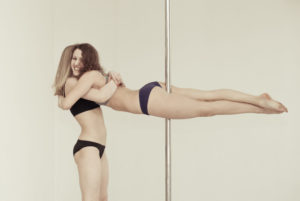Playing Hopscotch
Children, who love to play, live in many adults. A competitive or gaming element, added to training, makes it less stressful, more exciting and just cheerful.
It doesn’t mean that each training session in pole dance must be turned into a sandbox game, but it does mean that sometimes it’s worthwhile to add some entertainment to the austere training realities.
Think of a warming-up in pairs or groups. Many students dislike a warming-up. But exercises in pairs will cheer them up if they are interesting and original.
- Bring in a competitive Add to the training such tasks as “who will make more approaches” and “who will endure the element longer.”

Instruct the students to make a joint connection. Set out the first stunt. Following this, each student will gradually add one element, while the whole group must repeat this combination, first from two and then three, then four, and so on till their strength lasts.
- A task for partial improvisation. Propose to the students that they make their own connection from tricks, using specific elements. The task can be made still more complex by supplying the first and last elements while the studnet himself must invent a middle link.
Here are two more tasks that can help recall and digest the acquired skills:
– Show 10 methods of entering the trick and exiting it;
– Recall as many as possible ways of getting up from the floor to the pylon;
– Make up a combination of any elements which enables mounting the pylon without using the standard manhole;
– Make up a combination of any elements which enables coming down from the top of the pylon to the floor without using the stalls.
During the training games the sophisticated tricks will not seem unfeasible to the studnets, and
even the most tired of them will get a second wind. This is a simple way of encouraging the
students and motivating them to try harder than usual.
Tag:fitness, improvisation, Pole Dance, pylon, sport, student, techique, trick



